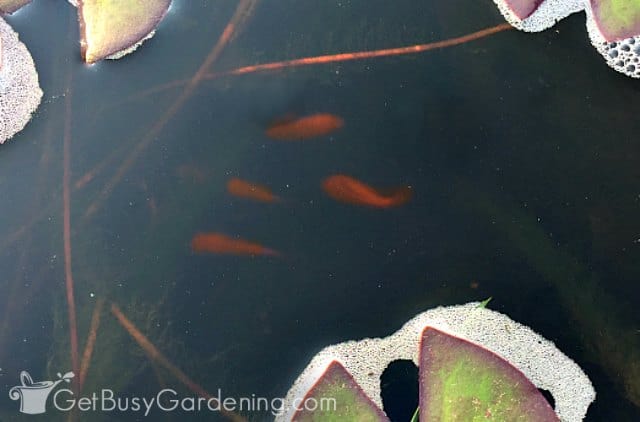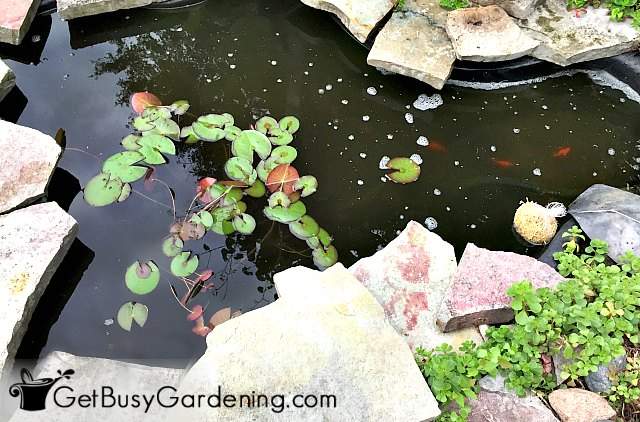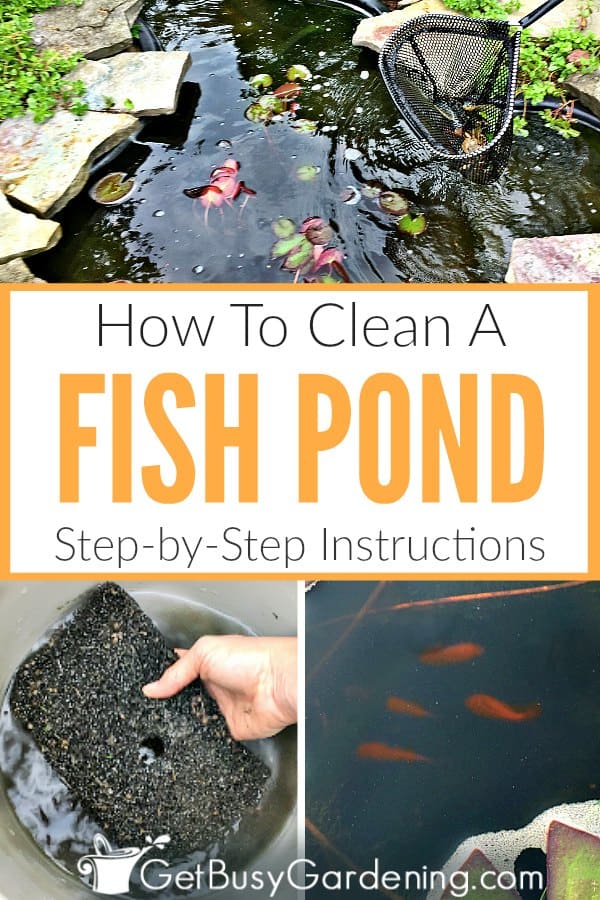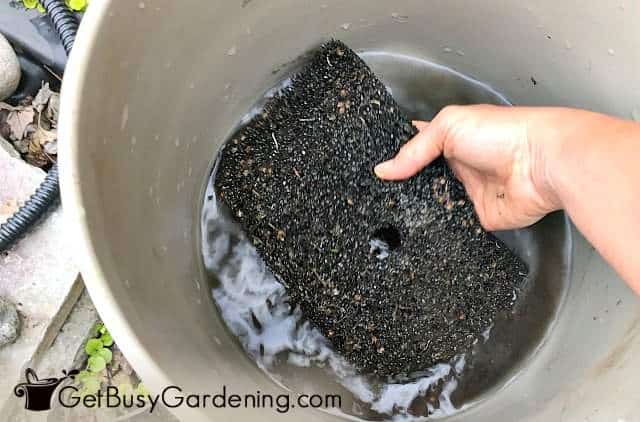Having a garden fish pond is awesome, but cleaning it can be a huge struggle. Well guess what… it doesn’t have to be difficult, and you don’t need any special equipment to get the job done.
In this post, I will share my detailed instructions for how to clean your fish pond, and give you tips for keeping it that way without all the hassle.
I’ve battled with keeping my pond clean in the past, so I’m here to tell you that the struggle is real. Mine got so bad and stinky one year that I was ready to pull out the liner and fill in the hole. Ugh!
But once I learned how to properly take care of it, and why it got so dirty and gross in the first place, cleaning it became much easier.

How To Clean Your Fish Pond Step-By-Step
Below is what you’ll need for cleaning your fish pond, and the exact steps to take. Once you get the steps down, it will be quick and easy.
Supplies Needed
- Skimmer net
- 5 gallon bucket
- Rubber gloves (optional)
- Large container or bucket (if removing your fish)
Step By Step Instructions
Step 1: Skim the surface – Use your skimmer net to clean the top of the surface of the water, removing all of the floating leaves and other debris.
Step 2: Remove the pump, plants, and decorations – Removing your pump (be sure to unplug it first!) as well as any plants and decorations from the pond will make it much easier to clean the sides and bottom.
At this time it’s a good idea to clean up your plants by trimming away any dead leaves, stems, and roots. You can also rinse them off to get rid of any muck or debris that came out of the pond with them, if necessary.
Step 3: Remove the fish (optional) – For light cleaning, you can just leave your fish in the pond and safely skip this step. But if your pond is really dirty, the water smells bad, or there’s a lot of muck on the bottom, then I recommend removing the fish before you start the next step.
To do that, fill up a container that’s deep enough to hold them, using water from the pond. DO NOT use the hose or tap water to fill your bucket, because the chlorine will kill your fish.
Transfer the fish into the container, and cover it with netting or lightweight mesh so they can’t jump out (don’t seal the container though, they need air!). Keep your fish out of the sun until you’re done cleaning the pond.

Step 4: Clean the muck off the bottom – To clean the bottom of my pond, I use my net. I simply drudge the bottom, and scoop out all of the leaves and muck that I can.
Be sure to get into all the corners, and clean off any plant shelves too. You could also try using a small pond vacuum or pool skimmer if you have one available to you.
Step 5: Scrub the sides – You don’t need to scrub the inside walls totally clean here. But if your pond is really mucky and dirty, then scrub off some of the thick coating that covers the walls.
I find that a basic toilet brush works great for this, but you could use a different type of long-handled brush if you have one on hand.
If your pond is green and overtaken by a weedy growth, then learn how to clear pond water and control algae naturally here.
Step 6: Clean the pump and filter – It’s a good idea to fill a 5 gallon bucket with pond water (or use rainwater) to rinse the pump and filter, rather than using your garden hose. Otherwise the chlorine will kill the beneficial bacteria.
By the way, if you don’t have a pump and filter yet, I highly recommend getting one. It’s much, much harder to maintain a healthy and clean fish pond without them.
I bought a basic submersible pump for my small pond and waterfall, and I put it into a universal filter box.
Step 7: Put everything back into the pond – Now that you’re done cleaning your pond, you can put the pump, plants, decorations, and fish back in.
If you drained your pond and filled it back up with chlorinated water, be sure to let it sit for at least 24 hours before putting your fish back into it, otherwise the chlorine could kill them.
How To Keep Your Pond Clean
Once you do the work to clean your pond, you want to keep it that way as long as possible, right? Yes! So here are a few tips to make it easy…
- If you don’t already have one, buy a pond pump and a filter box to keep the water aerated and cleaner longer.
- Rinse the filter every-other-week, or weekly if your pond tends to get dirty faster.
- Remove floating debris on a regular basis. This is especially important in the fall when the leaves are dropping, and in the spring when tree seeds are dropping (like those dreaded maple tree helicopters!).
- If you struggle to keep your pond clean, get a simple test kit and check the water. This will tell you exactly what you need to add to keep it in balance.
- You could also try using an enzyme cleaner. It contains a naturally occurring bacteria that consumes pond sludge and muck to help keep the water clean.
- Put bird netting or pond netting over the top in the fall and spring to help keep the leaves and other debris out.
- If you live in a cold climate, remove as much debris as you can in the fall before your pond freezes over, and add some beneficial bacteria to prevent the water from going bad over the winter.
Related Post: How To Winterize Your Garden Pond Step-By-Step

FAQs
You don’t need to drain the water if you clean your pond on a regular basis. However, if it’s really mucky or muddy, or you’ve never cleaned it before, then draining it will make the job much faster and easier.
I recommend removing your fish before cleaning your pond if it is really soupy, murky, or muddy, or if there’s a huge pile of muck on the bottom. Otherwise, disturbing the thick muck or muddy water could release toxic gasses that can suffocate and kill the fish.
Cleaning fish ponds isn’t the funnest job, and sometimes it can be downright disgusting. But if you follow my instructions and tips, you’ll be able to enjoy yours again in no time.
Share your fish pond cleaning tips and advice in the comments section below.







Linden Holston says
Article was very interesting and helpful
Eloy Lopez says
I read all the step-by-step on how to clean my 700 gallon pond and it was very helpful..we had it built by a pond guy last year but it doesn’t have a filter to clean out, can one be added? Thank you..
Amy Andrychowicz says
It depends on the type of pump you have, but most pond pumps should have the option of adding a filter.
David Matula says
have recently gotten a house with approximately 700 gallon koi pond with 25 Koi 8 to 12 long the previous owner said there it is and the water is very green , thinking ALGAEFIX . Do I mix in a 5 gallon bucket first then add to pond ???
Amy Andrychowicz says
I’ve never used the product that you mention, so I can’t answer your specific question. But I recommend following the instructions on the bottle to a T to make sure it doesn’t harm your fish.
Stewart Johnson says
You may have too many fish in the pond. The recommendation is one koi in 220 gallons. You should not have 25 koi in there, too much fish crap.
Crystal says
My pond is a large dugout 175 feet by 80 feet 4 feet deep. I have uncountable number of gold fish in it to eat mosquitos. Pond has turned pea soup green have been running g pond filter to no help . Fish still alive help.need clear water
Amy Andrychowicz says
Have you tried using barley straw yet? It takes time to clear the pond water, but works great. Follow the steps above, and you should be able to get rid of the algae in no time.
T says
Get yourself a UV Clarifier!! It was the best investment for me so far!!!
Barb says
I have a preformed pond liner and have some green algae on the sides. Can I take a sponge and wipe off the sides of the pond or is this considered the good bacteria that helps to keep my pond water clear?
Amy Andrychowicz says
As long as the green algae on the sides of your pond liner isn’t taking over and making the water mucky, then there’s no reason to clean it off.
David B. Hensley says
Great article. We have a 300-gallon pond and five fish. What is a safe way to remove our fish from the pond when cleaning?
Amy Andrychowicz says
Fill a container with some of the pond water, and then put the fish in there while you’re cleaning the pond. Don’t use tap water, it contains chemicals that can quickly kill the fish.
Charmaine Swift says
Hi I have a pond in the corner of my back garden which we inherited when we bought the house, and I love it! I have 7 fish, a water Lilly and some iris plants and pond weed. This past month or so, the water has gone green and I have string algae. I clear the algae regularly and cut back the pond weed regularly too. But now the pond weed seems to be choking and dieting which I think is causing or exacerbating the problem. Should I take out the pond weed totally and clear some of the sludge at the bottom, will this help? I have ordered some barley hay as you recommended.
Amy Andrychowicz says
Yes, sometimes when pond plants become established, they can take over and start to choke out other plants as well as the fish – especially in a small pond. If that is happening with yours, then I would personally take it out. One plant is usually more than enough for a small backyard garden pond, and water lilies are wonderful. Cleaning out the sludge at the bottom will help as well.
Gaynor says
We have one gold fish in a large plastic tub, it has been there for about 14 months and seems quite happy but I want to move it to a larger plastic tub. Should this be a problem, will take the advice you have given, thank you
Amy Andrychowicz says
Just allow the chlorine to evaporate for 24-48 hours before moving your goldfish into the newly filled pond. Otherwise the chlorine will kill them.
Mike Hesson says
Maintain a healthy fish population… Don’t over-feed your fish… Create a proper balance of plants… Clean debris from pond before it has a chance to decay… Choose proper filtration for your pond…these are some good efforts to keep your fish pond clean.
Amy Andrychowicz says
Awesome, thanks for your added tips!
Corinne Klock says
My 90 gallon pond is empty of plants and fish now and the water smells and is gray,can I add clorox and will that help?
Amy Andrychowicz says
Since your pond is so small, I would recommend draining the water, cleaning out the muck and mud, then filling it again with fresh water. It would be much faster than trying to treat the water with chemicals. Plus you’ll be able to add fish and plants much sooner.
Francine Cutura says
No Clorox. If it’s not totally removed it could be damaging to the fish.